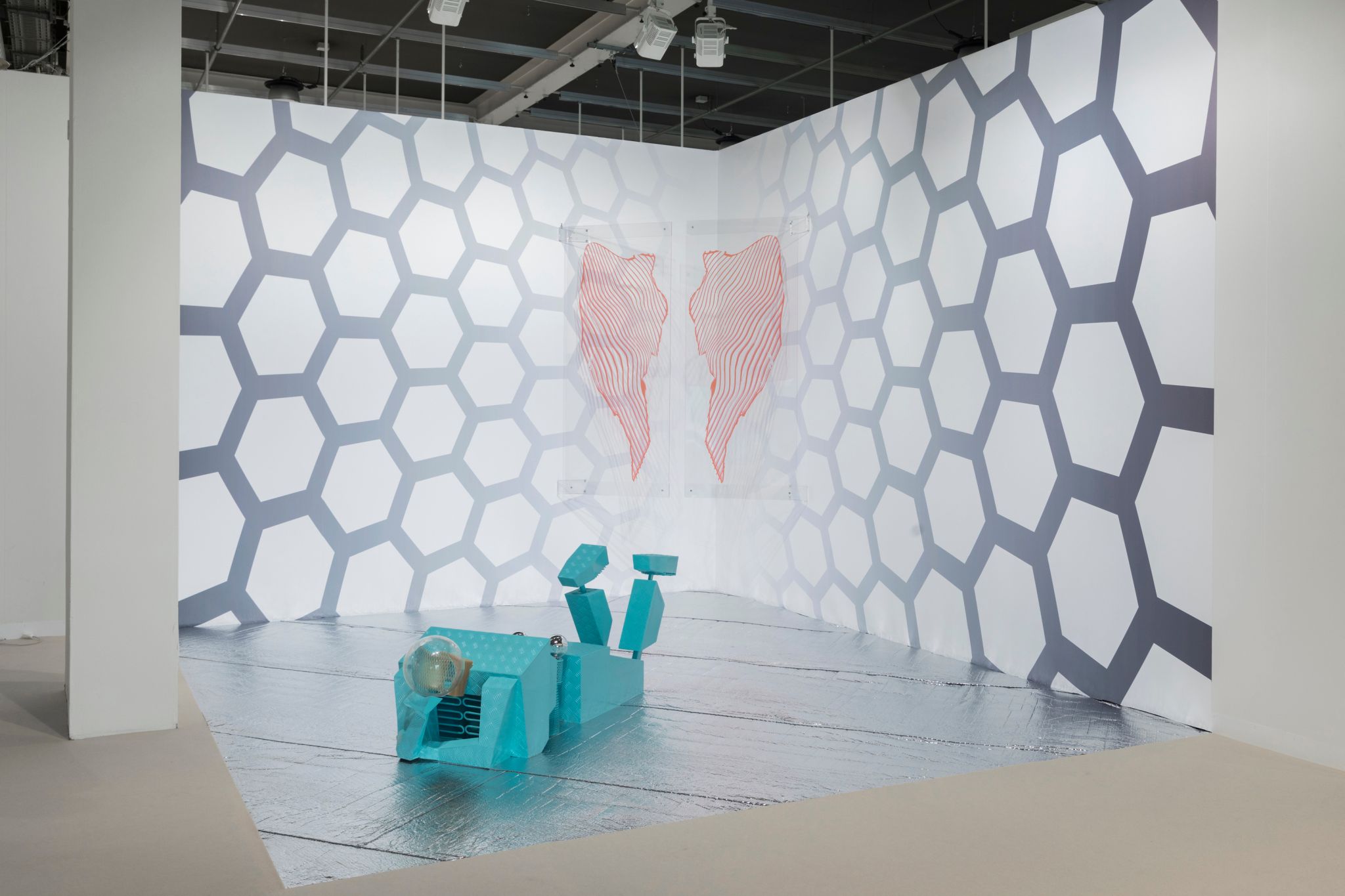Appropriation and re-arrangement are a continuous in Flaka Haliti’s productions, whereby new aesthetic patterns are created. So is the case of Its Urgency got lost in reverse (while being in constant delay) #2 (2018). In the first part #1 a green robot made out of objects stemming from the KFOR military camps in Kosovo and later recycled by the artist was placed sitting down in a space. Surrounded by a grid-like painted wall and a pair of wings printed on a transparent surface drilled to the wall. The robot sits on a silver floor consisting of isolation mats, which, together with all the other elements, turned the space into an immersive futuristic scenario.
read more
For part #2, Flaka Haliti created a new version of the robot –now turquoise– lying down in the middle of the space. In this new scenario, the robot acts again as a trans-historic device: The objects composing the robot – originally used during the NATO peacekeeping force by the foreign military troops– have been transformed by the artist in a way that marks the subversion and decolonisation of the used materials. By altering them and showing them in a new context, Haliti creates a space of trans-temporal narratives. Past, present and future blur in an amalgam of temporalities, thus turning the robot into a metaphor for time.Besides the robot, two wings printed on transparent plexiglass are present in the room, adding a new dimension. The wings recall those of Italian fifteenth-century Annunciations and the artist, fascinated by their omnipresence in renaissance representations, appropriated them in a similar way than the military objects. The wings are a supplementary element in the scene, contrasting with the robot’s laziness which, opposed to the usual representation of robots, remains passive. Both elements act as complementary opposites activating certain tension; the flying wings are light, almost virtual, in contrast to the heaviness and physicality of the robot.All described elements are placed in a space defined by a honeycomb-like grid with hexagonal tiling and a floor covered with isolation mats. The scenario leads the spectator into a heterotopian dimension. A hexagonal tiling is the best way to divide a surface into regions of equal area with the least total perimeter and it is an effective structure used by bees for honey production. In evolutionary terms, a honeycomb is a structure of relatedness, also called eusociality. Meaning good and social, a eusociality is based on cooperative care, overlapping generations within an adult colony, and a division of labor into reproductive and non-reproductive groups.Those care-based, cooperative social structures can also be related with Cuban academic Jose Esteban Muñoz’s ideas of futurities through social relations and a parallel could be traced between them and certain relations between Kosovo and the West. Muñoz stated in his book Cruising Utopia: The Then and There of Queer Futurity that the future opens a range of possibilities for minorities, which can arise through the development of aesthetic strategies. Following Munoz’s ideas of a possible Queer Futurity, Haliti imagines her own worlds, in order to look for future ideas of queerness and possibilities other that heteronormativity.Furthermore, Haliti’s work is influenced by Edouard Glissant’s idea of interrelatedness meaning all the elements of the installation are interrelated and presented as a whole; as a heterotopian universe created to subvert established ideas. The found objects, the grid, the wings, the colours, all are interdependent in Haliti’s narrative in which she suggests a non-hierarchical, queer horizon. Those aesthetic strategies using grids and expandable architectures that Haliti conceived in previous projects such as Speculating on the Blue (2015) at the Pavilion of The Republic of Kosovo at the 56th Venice Biennale, are consolidated in Its Urgency got lost in reverse (while being in constant delay) #2.


